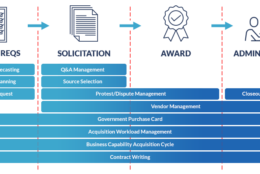Hubbard Radio Washington DC, LLC. All rights reserved. This website is not intended for users located within the European Economic Area.
On Air: Federal News Network
Appian
-
Federal acquisition management is ideally suited to benefit from automation.
July 30, 2020 -
Shifting from low-value to high-value work is a longstanding goal of federal management agendas. The use of automation and procurement-as-a-service expertise and analytics, which can free employees from routine tasks, have earned much attention – for good reason.
July 27, 2020 -
Low-code automation turns application development into an accessible, visual drag-and-drop process, allowing application designers to drag objects onto a canvas to draw their business processes, user interfaces, integrations, rules and every other element of an application.
June 03, 2020 -
The reality is, you can’t just lump your workforce together into one unit and send them back to the office.
May 27, 2020 -
In cases of an economic crisis, regulatory and oversight bodies must move just as quickly to respond to stimulus programs and the demands of a volatile market.
April 17, 2020 -
This content is provided by Appian. Deloitte has helped many federal agencies move off their legacy systems and onto modern platforms. In doing so, Deloitte has been able to identify common use cases for IT modernization…
March 23, 2020 -
Appian's Michael Beckley recently joined Federal News Network to discuss both the challenges and opportunities of automation.
January 27, 2020 -
Organizations are considering ways to accelerate modernization—and moving away from custom development is becoming part of that strategy.
January 27, 2020 -
Low code is a new take on development that embraces agile, lowers the barrier to entry, and integrates easily with existing systems, allowing agencies to fill in the blanks while also making individual applications easier to modernize.
November 13, 2019 -
Learn how low-code technologies and approaches can speed your agency’s journey to modern, world-class applications.
August 27, 2019 -
Mike Beckley, founder and CTO of Appian, joins host John Gilroy on this week's Federal Tech Talk to discuss how the company's low code approach will revolutionize how custom software gets built.
June 24, 2019













